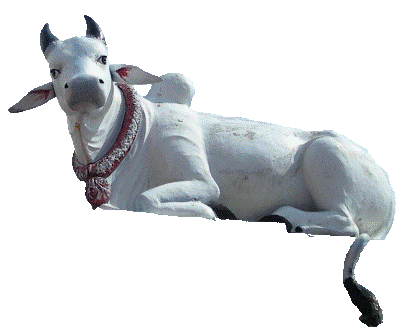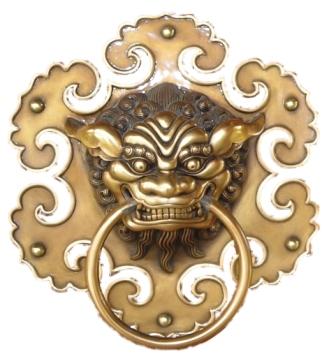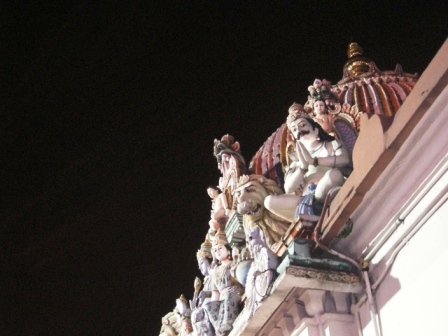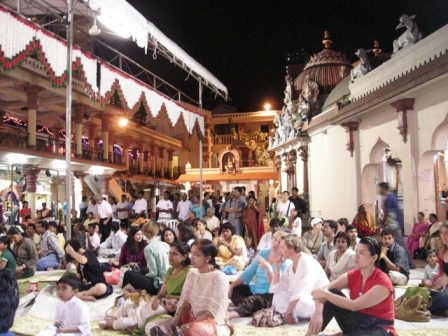 Navarathri Festival at the Navarathri Festival at the
Sri Mariamman Temple
 Today, 8 October 2008, is Saraswathi Puja. Today marks the culmination of 9 continuous nights of prayer, music and dance celebrating the Divine Feminine. The nine nights are called Navarathri and each day of the 9 nights the Goddess in the various temples in Singapore is honored with prayers. She is also dressed up according to mythological stories and is often decked with flowers, jewelry and silk sari. Alangaram or the art of dressing up the divine is a very special part of the Navarathri festival. Every Goddess in the various temples in Singapore are dressed up differently and the alangarams are listed in the local Tamil newspaper, Tamil Murasu. Alangarams are designed to inspire love, prosperity and beauty in the hearts of the devotees who come to the temple. It is also seeks to connect the average devotee with a world of possibilities in his or her own life by meditating on the Goddess energy. Today, 8 October 2008, is Saraswathi Puja. Today marks the culmination of 9 continuous nights of prayer, music and dance celebrating the Divine Feminine. The nine nights are called Navarathri and each day of the 9 nights the Goddess in the various temples in Singapore is honored with prayers. She is also dressed up according to mythological stories and is often decked with flowers, jewelry and silk sari. Alangaram or the art of dressing up the divine is a very special part of the Navarathri festival. Every Goddess in the various temples in Singapore are dressed up differently and the alangarams are listed in the local Tamil newspaper, Tamil Murasu. Alangarams are designed to inspire love, prosperity and beauty in the hearts of the devotees who come to the temple. It is also seeks to connect the average devotee with a world of possibilities in his or her own life by meditating on the Goddess energy.
In Hindu pantheon the Goddess or Sakti occupies a very central and critical role in temple worship. In fact there is a common Tamil saying that without Sakti Shiva cannot dance. In other worlds Sakti supplies the feminine energy that helps unlock and unleash the masculine energy which then manifests itself in the world as achievement and progress. The yin-yang principle and the duality within each of us is celebrated through this elaborate festival. The divine feminine of the Goddess energy is embodied in the holy trinity of Durga, Lakshmi and Saraswati.
Navarathri is also a festival of music and dance - where one channels the divine through singing and movement. This year when I was dancing at the Mariammman temple - many people in the audience reflected on how they felt like they were watching the Goddess herself dance through me. I cannot hope for a higher compliment. For temple dancers this is what we seek - to help connect our audiences to the Goddess through our song and dance. We become an instrument for the divine. Movement and song is about the glory of God. Not about personal vanity or ego. As I attain greater spiritual maturity I feel more and more connected to the Goddess energy in the temples in Singapore. And this in turn has fundamentally altered my approach to my art. I feel now more than ever that that for me dance has become prayer through movement.
Today is the last night to catch the various cultural shows in the various temples in Singapore. Saraswati Puja is celebrated with much pomp and grandeur in Singapore. You can also expect some wonderful singing and dancing in the temple tradition in Chettiar temple, Mariamman temple as well as the Durga temple in potong pasir. The last night of Navarathri or Saraswathi Puja is also when school going children and everyone who is a life-long learner prayers to Saraswati - the Goddess of wisdom, arts and spirituality. Praying to Saraswati would help the devotee enhance her learning skills and secure good results in exams. Saraswati is always shown wearing a white sari that represents purity and she carries a veena - a musical instrument that connects us to the sound of life. As an Indian woman growing up within the tradition Saraswati puja has always been incredibly important to me. This is the day we put all our books before the altar and offer special prayers to Saraswati so that she gives us wisdom and keen intellect. I love this tradition - it has helped me revere the power of education and hardwork.
As a dancer the tenth day - ie tomorrow is also very important to me. This 10th day is called Vijayadhasami and this is the day that we honor our gurus - the ones who will pass down artistic and spiritual knowledge to us. We often offer our teachers a tray of fruits, flowers and sari to show our love and respect for what she has been teaching us. I think this is again is a wonderful tradition that takes education to a higher spiritual dimension and makes us realize that education is truly a privilege, not an entitlement. And being blessed with a great guru is indeed a great privilege. I have had been blessed with many wonderful gurus in my life who have inspired some of my best performances in both the professional world as well as the dance world.
In North India which has lesser influence in Singapore given our strong Tamil communities and historic ties with Tamil Nadu, Navarathri is called Durga Puja and all nine nights are dedicated to Durga. There is also a legend surround Durga Puja relating to Durga defeating a demon. However, most Indian Singaporeans who celebrate Navarathri come from the South Indian tradition and most of the temple traditions in Singapore are centered around the interpretation of Navarathri as paying homage to the Holy Trinity in the feminine form.
Article contributed by Ms. Arul Ramiah
www.dasidance.blogspot.com
Related Articles:


|








Audiences watching the Navathri performance
|


 Today, 8 October 2008, is Saraswathi Puja. Today marks the culmination of 9 continuous nights of prayer, music and dance celebrating the Divine Feminine. The nine nights are called Navarathri and each day of the 9 nights the Goddess in the various temples in Singapore is honored with prayers. She is also dressed up according to mythological stories and is often decked with flowers, jewelry and silk sari. Alangaram or the art of dressing up the divine is a very special part of the Navarathri festival. Every Goddess in the various temples in Singapore are dressed up differently and the alangarams are listed in the local Tamil newspaper, Tamil Murasu. Alangarams are designed to inspire love, prosperity and beauty in the hearts of the devotees who come to the temple. It is also seeks to connect the average devotee with a world of possibilities in his or her own life by meditating on the Goddess energy.
Today, 8 October 2008, is Saraswathi Puja. Today marks the culmination of 9 continuous nights of prayer, music and dance celebrating the Divine Feminine. The nine nights are called Navarathri and each day of the 9 nights the Goddess in the various temples in Singapore is honored with prayers. She is also dressed up according to mythological stories and is often decked with flowers, jewelry and silk sari. Alangaram or the art of dressing up the divine is a very special part of the Navarathri festival. Every Goddess in the various temples in Singapore are dressed up differently and the alangarams are listed in the local Tamil newspaper, Tamil Murasu. Alangarams are designed to inspire love, prosperity and beauty in the hearts of the devotees who come to the temple. It is also seeks to connect the average devotee with a world of possibilities in his or her own life by meditating on the Goddess energy.







